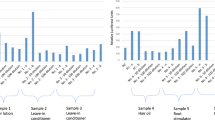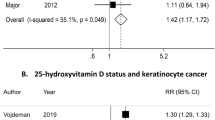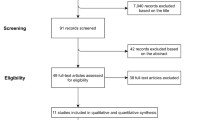Abstract
Background
Hair relaxers and skin lighteners have been commonly used by African women, with suggestions that they may have hormonal activity.
Objectives
To investigate the relationship of hair relaxer and skin lightener use to serum estrogen/estrogen metabolite levels.
Methods
We utilized the postmenopausal population-based controls of the Ghana Breast Health Study to estimate adjusted geometric means (GM) and 95% confidence intervals of individual circulating estrogen levels by hair relaxer/skin lightener exposure categories.
Results
Of the 585 postmenopausal women included in our analysis, 80.2% reported hair relaxer use and 29.4% skin lightener use. Ever hair relaxer use was positively associated with estriol (adjusted GM 95.4 pmol/L vs. never 74.5, p value = 0.02) and 16-epiestriol (20.4 vs. 16.8, p value = 0.05) particularly among users of lye-based hair relaxers. Positive associations between scalp burns and unconjugated estrogens were observed (e.g., unconjugated estrone: 5+ scalp burns 76.9 [59.6–99.2] vs. no burns 64.0 [53.7–76.3], p-trend = 0.03). No association was observed between use of skin lighteners and circulating estrogens.
Significance
This study presents evidence that circulating 16-pathway estrogens (i.e., estriol and 16-epiestriol) may be increased in users of lye-based hair relaxer products. Among hair relaxer users, unconjugated estrogen levels were elevated in women with a greater number of scalp burns.
Impact statement
In this population-based study of hair relaxer and skin lightener use among postmenopausal women in Ghana, altered estrogen metabolism was observed with hair relaxer use, particularly among women using lye-based products or with a greater number of scalp burns. In contrast, skin lightener use was not associated with differences in estrogen metabolism in this population. Continued investigation of the potential biological impact on breast cancer risk of hair relaxer use is warranted.
This is a preview of subscription content, access via your institution
Access options
Subscribe to this journal
Receive 6 print issues and online access
$259.00 per year
only $43.17 per issue
Buy this article
- Purchase on Springer Link
- Instant access to full article PDF
Prices may be subject to local taxes which are calculated during checkout

Similar content being viewed by others
Data availability
The datasets generated or analyzed for the current study are not publicly available due to data privacy of patients but are available from the corresponding author upon reasonable request.
Change history
29 January 2022
A Correction to this paper has been published: https://doi.org/10.1038/s41370-022-00415-y
References
Aryiku SA, Salam A, Dadzie OE, Jablonski NG. Clinical and anthropological perspectives on chemical relaxing of afro-textured hair. J Eur Acad Dermatol Venereol. 2015;29:1689–95.
de Sá Dias TC, Baby AR, Kaneko TM, Robles Velasco MV. Relaxing/straightening of Afro-ethnic hair: historical overview. J Cosmet Dermatol. 2007;6:2–5.
Sishi VNB, Van Wyk JC, Khumalo NP. The pH of lye and no-lye hair relaxers, including those advertised for children, is at levels that are corrosive to the skin. S Afr Med J. 2019;109:941–6.
Benn EK, Alexis A, Mohamed N, Wang YH, Khan IA, Liu B. Skin bleaching and dermatologic health of African and Afro-Caribbean populations in the US: new directions for methodologically rigorous, multidisciplinary, and culturally sensitive research. Dermatol Ther. 2016;6:453–9.
Dlova NC, Hamed SH, Tsoka-Gwegweni J, Grobler A. Skin lightening practices: an epidemiological study of South African women of African and Indian ancestries. Br J Dermatol. 2015;173:2–9.
Ladizinski B, Mistry N, Kundu RV. Widespread use of toxic skin lightening compounds: medical and psychosocial aspects. Dermatol Clin. 2011;29:111–23.
Lartey M, Krampa FD, Abdul-Rahman M, Quarcoo NL, Yamson P, Hagan PG, et al. Use of skin-lightening products among selected urban communities in Accra, Ghana. Int J Dermatol. 2017;56:32–39.
Brinton LA, Figueroa JD, Ansong D, Nyarko KM, Wiafe S, Yarney J, et al. Skin lighteners and hair relaxers as risk factors for breast cancer: results from the Ghana breast health study. Carcinogenesis. 2018;39:571–9.
Osei M, Ali M, Owusu A, Baiden F. Skin-lightening practices among female high school students in Ghana. Public Health. 2018;155:81–87.
Peltzer K, Pengpid S, James C. The globalization of whitening: prevalence of skin lighteners (or bleachers) use and its social correlates among university students in 26 countries. Int J Dermatol. 2016;55:165–72.
Crawford K, Hernandez C. A review of hair care products for black individuals. Cutis. 2014;93:289–93.
Hauser R, Calafat AM. Phthalates and human health. Occup Environ Med. 2005;62:806–18.
Darbre PD. Environmental oestrogens, cosmetics and breast cancer. Best Pract Res Clin Endocrinol Metab. 2006;20:121–43.
Giulivo M, Lopez de Alda M, Capri E, Barceló D. Human exposure to endocrine disrupting compounds: their role in reproductive systems, metabolic syndrome and breast cancer. A review. Environ Res. 2016;151:251–64.
Diamanti-Kandarakis E, Bourguignon JP, Giudice LC, Hauser R, Prins GS, Soto AM, et al. Endocrine-disrupting chemicals: an Endocrine Society scientific statement. Endocr Rev. 2009;30:293–342.
Maneli MH, Wiesner L, Tinguely C, Davids LM, Spengane Z, Smith P, et al. Combinations of potent topical steroids, mercury and hydroquinone are common in internationally manufactured skin-lightening products: a spectroscopic study. Clin Exp Dermatol. 2016;41:196–201.
Romero-Franco M, Hernández-Ramírez RU, Calafat AM, Cebrián ME, Needham LL, Teitelbaum S, et al. Personal care product use and urinary levels of phthalate metabolites in Mexican women. Environ Int. 2011;37:867–71.
Llanos AAM, Rabkin A, Bandera EV, Zirpoli G, Gonzalez BD, Xing CY, et al. Hair product use and breast cancer risk among African American and White women. Carcinogenesis. 2017;38:883–92.
Rosenberg L, Boggs DA, Adams-Campbell LL, Palmer JR. Hair relaxers not associated with breast cancer risk: evidence from the black women’s health study. Cancer Epidemiol Biomark Prev. 2007;16:1035–7.
Coogan PF, Rosenberg L, Palmer JR, Cozier YC, Lenzy YM, Bertrand KA. Hair product use and breast cancer incidence in the Black Women’s Health Study. Carcinogenesis. 2021;42:924–30.
Brinton LA, Trabert B, Anderson GL, Falk RT, Felix AS, Fuhrman BJ, et al. Serum estrogens and estrogen metabolites and endometrial cancer risk among postmenopausal women. Cancer Epidemiol Biomark Prev. 2016;25:1081–9.
Trabert B, Brinton LA, Anderson GL, Pfeiffer RM, Falk RT, Strickler HD, et al. Circulating estrogens and postmenopausal ovarian cancer risk in the women’s health initiative observational study. Cancer Epidemiol Biomark Prev. 2016;25:648–56.
Sampson JN, Falk RT, Schairer C, Moore SC, Fuhrman BJ, Dallal CM, et al. Association of estrogen metabolism with breast cancer risk in different cohorts of postmenopausal women. Cancer Res. 2017;77:918–25.
Yager JD, Davidson NE. Estrogen carcinogenesis in breast cancer. N Engl J Med. 2006;354:270–82.
Brinton LA, Awuah B, Nat Clegg-Lamptey J, Wiafe-Addai B, Ansong D, Nyarko KM, et al. Design considerations for identifying breast cancer risk factors in a population-based study in Africa. Int J Cancer. 2017;140:2667–77.
Nyante SJ, Biritwum R, Figueroa J, Graubard B, Awuah B, Addai BW, et al. Recruiting population controls for case-control studies in sub-Saharan Africa: the Ghana Breast Health Study. PLoS One. 2019;14:e0215347.
Xu X, Roman JM, Issaq HJ, Keefer LK, Veenstra TD, Ziegler RG. Quantitative measurement of endogenous estrogens and estrogen metabolites in human serum by liquid chromatography-tandem mass spectrometry. Anal Chem. 2007;79:7813–21.
Loud JT, Gierach GL, Veenstra TD, Falk RT, Nichols K, Guttmann A, et al. Circulating estrogens and estrogens within the breast among postmenopausal BRCA1/2 mutation carriers. Breast Cancer Res Treat. 2014;143:517–29.
Xu X, Roman JM, Issaq HJ, Keefer LK, Veenstra TD, Ziegler RG. Quantitative measurement of endogenous estrogens and estrogen metabolites in human serum by liquid chromatography-tandem mass spectrometry. Anal Chem. 2007;79:7813–21.
James-Todd T, Senie R, Terry MB. Racial/ethnic differences in hormonally-active hair product use: a plausible risk factor for health disparities. J Immigr Minor Health. 2012;14:506–11.
Galli CL, Bettin F, Metra P, Fidente P, De Dominicis E, Marinovich M. Novel analytical method to measure formaldehyde release from heated hair straightening cosmetic products: Impact on risk assessment. Regul Toxicol Pharm. 2015;72:562–8.
Bocca B, Pino A, Alimonti A, Forte G. Toxic metals contained in cosmetics: a status report. Regul Toxicol Pharm. 2014;68:447–67.
Kaličanin B, Velimirović D. A study of the possible harmful effects of cosmetic beauty products on human health. Biol Trace Elem Res. 2016;170:476–84.
Falk RT, Brinton LA, Dorgan JF, Fuhrman BJ, Veenstra TD, Xu X, et al. Relationship of serum estrogens and estrogen metabolites to postmenopausal breast cancer risk: a nested case-control study. Breast Cancer Res. 2013;15:R34.
Acknowledgements
The success of this investigation would not have been possible without exceptional teamwork and the diligence of the field staff who oversaw the recruitment, interviews and collection of data from study subjects. Special thanks are due to the following individuals: Korle Bu Teaching Hospital,Accra—Dr. Adu-Aryee, Obed Ekpedzor, Angela Kenu, Victoria Okyne, Naomi Oyoe Ohene Oti, Evelyn Tay; Komfo Anoyke Teaching Hospital, Kumasi— Marion Alcpaloo, Bernard Arhin, Emmanuel Asiamah, Isaac Boakye, Samuel Ka-chungu and; Peace and Love Hospital, Kumasi—Samuel Amanama, Emma Abaidoo, Prince Agyapong, Thomas Agyei-Ansong, Debora Boateng, Margaret Frempong, Bridget Nortey Mensah, Richard Opoku, and Kofi Owusu Gyimah. The study was further enhanced by surgical expertise provided by Dr. Lisa Newman of the University of Michigan and by pathological expertise provided by Drs. Stephen Hewitt and Petra Lenz of the National Cancer Institute, and Dr. Maire A. Duggan from the Cumming School of Medicine, University of Calgary, Canada. Study management assistance was received from Ricardo Diaz, Shelley Niwa, Usha Singh, Ann Truelove and Michelle Brotzman at Westat, Inc. Appreciation is also expressed to the many women who agreed to participate in the study and to provide information and biospecimens in hopes of preventing and improving outcomes of breast cancer in Ghana.
Funding
This research was supported in part by funds from the intramural research program of the National Cancer Institute, National Institutes of Health.
Author information
Authors and Affiliations
Contributions
AMG: statistical analysis, data interpretation, writing, and critical review of the manuscript. BT: study conception, study design, statistical analysis, interpretation of results, writing, and critical review of the manuscript. LAB: study conception, study design, data acquisition, data interpretation, writing, and critical review of the manuscript. XX: laboratory analysis and critical review of the manuscript. JF: study design, data acquisition, and critical review of the manuscript. TUA, MGC: data/study management and critical review of the manuscript. RTK, DA, JY, BWA, LE, FD, VV, NT, EA, FA, EOB, JO, RB, KN, SW, BA, JNCL: data acquisition and critical review of the manuscript. All authors read and approved the final manuscript.
Corresponding author
Ethics declarations
Competing interests
The authors declare no competing interests.
Ethics approval and consent to participate
All questionnaires were administered after obtaining written informed consent on forms approved by institutional review boards in the U.S. and Ghana.
Additional information
Publisher’s note Springer Nature remains neutral with regard to jurisdictional claims in published maps and institutional affiliations.
The original online version of this article was revised: In the original article the affiliation details for the authors Thomas U. Ahearn, Montserrat Garcia-Closas, Louise A. Brinton, and Britton Trabert were incorrectly assigned to affiliation "2" instead of "1".
Supplementary information
Rights and permissions
About this article
Cite this article
Geczik, A.M., Falk, R.T., Xu, X. et al. Relation of circulating estrogens with hair relaxer and skin lightener use among postmenopausal women in Ghana. J Expo Sci Environ Epidemiol 33, 301–310 (2023). https://doi.org/10.1038/s41370-021-00407-4
Received:
Revised:
Accepted:
Published:
Issue Date:
DOI: https://doi.org/10.1038/s41370-021-00407-4



